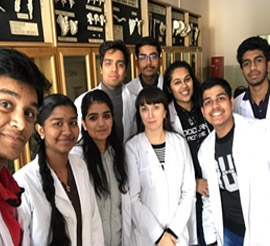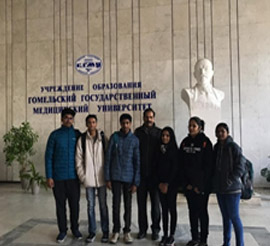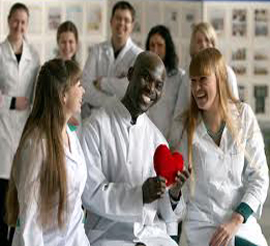
The history of medical education in the Gomel region began with the creation of a new medical school. Gomel State Medical University began to exist on 1 November 1990. Creating university was due to an acute need for medical personnel in the Gomel and Mogilev regions affected by the Chernobyl nuclear disaster, and the need for scientific research on the health consequences of the Chernobyl disaster and finding ways to overcome them.Became the first rector of the University of MD, Professor Yu Bandazheuski
Overcoming the difficulties, both in the country and related to their own development, the institute has made every effort to quality professional development faculty, improving the educational process, capacity of the material base.
New impetus to the development of the institute received with the arrival of the leadership of Professor Sergei Vladimirovich Skylark . In 2000, on the initiative of the rector of the decision of the Ministry of Health of the Republic of Belarus was the Faculty of training for foreign countries. The outcome of the commission for certification and accreditation of the Ministry of Education of the Republic of Belarus in July 2003, the Institute received a new status and was renamed the Educational Establishment "Gomel State Medical University."
In May 2007, the rector of the educational institution "Gomel State Medical University" became a Doctor of Medicine, Professor Anatoly Lyzikov.
During the existence of the university created a highly professional team, capable to train medical staff at the appropriate level, conduct research, provide medical advice to the public.us.
In 2010 , the GomSMU confirmed his high status, received accreditation for compliance provided educational services to the international standard ISO 9001:2008.
In April, 20 13 , the Ministry of Education of the Republic of Belarus held another certification in niversitetaperiod of 5 years.
"Gomel State Medical University" recognized by the World Health Organization, the National Medical Commission India, Sri Lanka and Pakistan, as well as commissions for medical graduates the U.S., UK and other countries
Почетная грамота и орден от президента Шри - Ланкибыли вручены ректору университета в 2010 году за вклад вмедицинское образование граждан Шри - Ланки
Medical University today is:
36 departments, the central research laboratory;
18 large clinics with modern equipment, which is made on the basis of training;
clinical facilities of the University is one of the best in Belarus, where the most modern medical technology for diagnosis and treatment of endocrine, cardiac, immunologic, hematologic, ophthalmic, cancer;
more than 4,000 (including more than 500 foreign) students in the Faculty of the University;
Library: regional center of scientific and medical information to healthcare professionals; holdings are more than 256 thousand items, including more than 73 thousands of scientific literature; University e-library - more than 2 thousands of digitized documents, access to global information resources HINARI , eLIBRARY .RU , PubMed, Academic library fund, consisting of 80,000 textbooks in Russian and foreign languages helps students learn medical sciences
4 well-appointed modern hostel.
Over the years, the university has trained more than 4,000 specialists in 54 medical specialties. Graduates work in clinics in various cities of the Republic of Belarus, the CIS countries, Western Europe and Asia.
Medical faculty is formed together with the establishment of the university. On 01.05.2014, at the faculty trained 2601 students. During the years of its existence has trained more than 3,000 professionals. Among them are many well-known physicians and policy-makers, scientists and teachers who work in our region and beyond. The main specialty of graduates - medical business.
At the medical faculty of the University is preparing physicians in specialties:
o surgical disease with a specialization in abdominal surgery, pediatric surgery, cardiovascular surgery, thoracic surgery, urology, ophthalmology, otolaryngology, dentistry, traumatology, orthopedics, oncology, anesthesiology and intensive care;
o internal medicine, specializing in therapy, pulmonology, tuberculosis, allergy, infectious and tropical diseases, hematology, endocrinology, neurology, neuropathology, dermatovenerology, geriatrics, diagnostic imaging and therapy, psychiatry;
o pediatrics specializing pediatricians, specialists in children's diseases in hematology, immunology, pulmonology, cardiology, gastroenterology, neurology, neonatology;
o obstetrics and gynecology specializing obstetricians, specialists in medical genetics.
.
In 1996, the first university in the country was opened medical-diagnostic department for training in clinical laboratory diagnosis. In November 2000, the Department was transformed into medical-diagnostic department, which in 2001 was renamed to reflect the new national classifications of occupations and qualifications of the Republic of Belarus in the medical-diagnostic department. Preparation of 719 students at the Faculty is conducted in "medical-diagnostic business" and "preventive medicine."
At the Faculty of Medical and diagnostic University conducted training diagnostic profile in the following areas: clinical laboratory diagnostics, functional diagnostics, beam diagnostics; preventive health profile: graduates are awarded the qualification of "physician-hygienist", they can work on medical positions in sanitation facilities (doctor hygienist, epidemiologist, doctor-laboratory of Hygiene and Epidemiology, doctor valeologist Health Center) and scientific research laboratories.
Preparatory Faculty established to increase knowledge of students required to pass the entrance exams to medical schools, as well as to provide a sound scientific cognitive framework conducive to the acquisition of quality medical sciences.
Training is conducted in the preparatory courses and preparatory (daily) office. At the preparatory department enrolls more than 400 students with secondary education.
Preparatory courses are in three forms: long (evening and correspondence), working for eight months, and short-term functioning for three weeks on the eve of the entrance exams.
At the preparatory department of foreign students for 10 months studying the Russian language, biology, chemistry, physics.
Faculty training for foreign countries prepare future physicians for Europe and Asia. 1-6 courses of faculty trained more than 500 foreign nationals from Lebanon, Syria, Palestine, Egypt, Jordan, Nepal, Pakistan, Sri Lanka, Iran and other countries.
The university created the necessary conditions for foreign students: fundamental clinical base, equipped with the best examples of foreign and domestic medical equipment, teachers and doctors with degrees in science, trained at the best hospitals in Europe, North America and Japan.
Corresponding to the world standards educational process provides a combination of deep theoretical knowledge with practical training fundamental. Specialization contributes to the quality of training, allows teachers to focus on the specific characteristics of the disease, diagnosis, treatment. This takes into account specific to the region, climatic, ethnic, economic and other impacts on human disease.
Training is conducted in all faculties of the University on 54 medical specialties.
At the end of university graduates are awarded the qualification of the doctor and the title of Doctor of Medicine.Education can be continued for any medical specialty in clinical internship, graduate school, internships.
specialty in clinical internship, graduate school, internships.
Postgraduate Education Department provides training of the teaching staff. Preparation takes place in the following forms:
o training of doctors-in-training in pediatrics, internal medicine, surgery, obstetrics and gynecology;
o training of domestic and foreign experts in the clinical residency;
o training in full-time and part-time postgraduate study;
o training of doctors of various specialties.
Gomel State Medical University is a major center of medical science in the Republic of Belarus.
The scientific work is conducted in 36 departments, five specialized research laboratories.
University scientists are involved in doing research on government programs, social orders in basic research (more than 20).
Twenty-first century advances in medicine caused not only the achievements of basic and applied sciences, biology, advanced technology projects, but also to a large extent the people implementing the results of theoretical medical developments in medical practice. Therefore, training of competent modern doctor with a thorough scientific knowledge, which owns diagnostic and treatment technologies, is one of the major tasks of higher medical education.Gomel State Medical University fully corresponds to the status of modern higher education.



